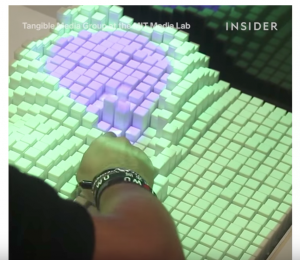Abstract / concept statement
inspiration is from a project from the MIT tangible media group titled “Moving Blocks Mimic Human Movements” (https://www.youtube.com/watch?v=PTm1e-tJJEg) . I intend to create an 2D array of movable blocks as in the picture below:

Each block would have a single neo pixel LED on top of it. The goal of the project would be to use this array to create a sort of “3D mirror” (the LED’s create the color; the blocks move up or down to add depth) reflecting objects/people front of it. In contrast to the MIT lab project which aims to mimic human movement, this project aims to mimic human appearance.
Hardware
- Kinect camera (depth sensing is easy with this)
- Raspberry pi (uses open cv to detect objects/humans, moves blocks/ add colour to LED’s accordingly)
- Acrylic blocks, have to laser cut (number depends on size of array, TBD)
- Singular adafruit neopixel LED’s (number depends on size of array, TBD)
- Multiplexing hardware (need to be able to control numerous blocks and LED’s, unsure of how many/what type)
- Solenoids/vacuum tubes? to move the blocks, unsure what hardware to use to facilitate easy vertical movement
Software
I’ll need some software that’s able to identify the contours of a person’s body (so I can do cool stuff like add depth with the blocks only to image person’s body), and openCV is perfect for this.
Order of construction and testing
- Figure out how to make a single acrylic piece move up and down at different levels, and add the neo pixel LED on top controlling both simultaneously.
- Figure out how to multiplex several blocks.
- Create a 2D array of blocks with LED’s on top.
- Create the multiplex and attach to rpi. Control the movement of the blocks/LEDs efficiently with RPI. Ask for help if required.
- Debug, and get feedback at this point.
- Figure out how to use the Kinect and openCV to get desired input.
- Control Blocks and LEDs with input
- show it to someone who isn’t in phys comp and ask them to try it out
- incorporate feedback, add aesthetic and make a case if required.
- make an information poster for the final show.
- write up my artist’s statement for the final show.